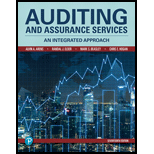
Auditing And Assurance Services
17th Edition
ISBN: 9780134897431
Author: ARENS, Alvin A.
Publisher: PEARSON
expand_more
expand_more
format_list_bulleted
Concept explainers
Textbook Question
Chapter 19, Problem 1RQ
Identify three asset accounts, three expense accounts, and three liability accounts typically associated with acquisition and payment cycle transactions.
Expert Solution & Answer
To determine
To identify three assets accounts, expenses accounts and liability account associated with acquisition and payment cycle transactions
Explanation of Solution
The accounts associated with acquisition and payment cycle transactions are
| Assets accounts | Expenses accounts | Liability accounts |
| 1. Prepaid expenses accounts | 1. Rent and depreciation expenses | 1. Outstanding taxes accounts |
| 2. Land and property account | 2. Maintenance expenses | 2. Accounts payable |
| 3. Machinery and equipment account | 3. Income tax expenses accounts | 3. Outstanding insurance account |
Table (1)
Want to see more full solutions like this?
Subscribe now to access step-by-step solutions to millions of textbook problems written by subject matter experts!
Students have asked these similar questions
General Accounting
Calculate the price- earnings ratio accounting question
Please provide the accurate answer to this general accounting problem using valid techniques.
Chapter 19 Solutions
Auditing And Assurance Services
Ch. 19 - Identify three asset accounts, three expense...Ch. 19 - Explain the relationship between substantive tests...Ch. 19 - Prob. 3RQCh. 19 - Prob. 4RQCh. 19 - Prob. 5RQCh. 19 - Prob. 6RQCh. 19 - Prob. 7RQCh. 19 - Prob. 8RQCh. 19 - Prob. 9RQCh. 19 - Prob. 10RQ
Ch. 19 - Which documents will be used to verify accrued...Ch. 19 - Prob. 12RQCh. 19 - Prob. 13RQCh. 19 - Prob. 14RQCh. 19 - Prob. 15.1MCQCh. 19 - Prob. 15.2MCQCh. 19 - Prob. 15.3MCQCh. 19 - Prob. 16.1MCQCh. 19 - Prob. 16.2MCQCh. 19 - Prob. 16.3MCQCh. 19 - Prob. 17.1MCQCh. 19 - Prob. 17.2MCQCh. 19 - Prob. 17.3MCQCh. 19 - Prob. 18.1MCQCh. 19 - Prob. 18.2MCQCh. 19 - Prob. 18.3MCQCh. 19 - Prob. 19DQPCh. 19 - Prob. 20DQPCh. 19 - Prob. 21DQPCh. 19 - Prob. 22DQPCh. 19 - Prob. 24DQPCh. 19 - Prob. 25DQPCh. 19 - You are auditing the financial statements of...Ch. 19 - Prob. 27DQPCh. 19 - Prob. 28DQPCh. 19 - Prob. 29DQP
Knowledge Booster
Learn more about
Need a deep-dive on the concept behind this application? Look no further. Learn more about this topic, accounting and related others by exploring similar questions and additional content below.Similar questions
arrow_back_ios
SEE MORE QUESTIONS
arrow_forward_ios
Recommended textbooks for you
 Auditing: A Risk Based-Approach (MindTap Course L...AccountingISBN:9781337619455Author:Karla M Johnstone, Audrey A. Gramling, Larry E. RittenbergPublisher:Cengage Learning
Auditing: A Risk Based-Approach (MindTap Course L...AccountingISBN:9781337619455Author:Karla M Johnstone, Audrey A. Gramling, Larry E. RittenbergPublisher:Cengage Learning College Accounting, Chapters 1-27AccountingISBN:9781337794756Author:HEINTZ, James A.Publisher:Cengage Learning,
College Accounting, Chapters 1-27AccountingISBN:9781337794756Author:HEINTZ, James A.Publisher:Cengage Learning, Intermediate Accounting: Reporting And AnalysisAccountingISBN:9781337788281Author:James M. Wahlen, Jefferson P. Jones, Donald PagachPublisher:Cengage Learning
Intermediate Accounting: Reporting And AnalysisAccountingISBN:9781337788281Author:James M. Wahlen, Jefferson P. Jones, Donald PagachPublisher:Cengage Learning- Principles of Accounting Volume 1AccountingISBN:9781947172685Author:OpenStaxPublisher:OpenStax College
 Auditing: A Risk Based-Approach to Conducting a Q...AccountingISBN:9781305080577Author:Karla M Johnstone, Audrey A. Gramling, Larry E. RittenbergPublisher:South-Western College Pub
Auditing: A Risk Based-Approach to Conducting a Q...AccountingISBN:9781305080577Author:Karla M Johnstone, Audrey A. Gramling, Larry E. RittenbergPublisher:South-Western College Pub

Auditing: A Risk Based-Approach (MindTap Course L...
Accounting
ISBN:9781337619455
Author:Karla M Johnstone, Audrey A. Gramling, Larry E. Rittenberg
Publisher:Cengage Learning

College Accounting, Chapters 1-27
Accounting
ISBN:9781337794756
Author:HEINTZ, James A.
Publisher:Cengage Learning,

Intermediate Accounting: Reporting And Analysis
Accounting
ISBN:9781337788281
Author:James M. Wahlen, Jefferson P. Jones, Donald Pagach
Publisher:Cengage Learning

Principles of Accounting Volume 1
Accounting
ISBN:9781947172685
Author:OpenStax
Publisher:OpenStax College


Auditing: A Risk Based-Approach to Conducting a Q...
Accounting
ISBN:9781305080577
Author:Karla M Johnstone, Audrey A. Gramling, Larry E. Rittenberg
Publisher:South-Western College Pub
ACCOUNTING BASICS: Debits and Credits Explained; Author: Accounting Stuff;https://www.youtube.com/watch?v=VhwZ9t2b3Zk;License: Standard Youtube License